The ASUS ROG Maximus X Apex Review: X Marks the Spot, Literally
by Joe Shields on May 11, 2018 9:00 AM EST- Posted in
- Motherboards
- Intel
- Asus
- ROG
- Aquantia
- 5G
- Coffee Lake
- Z370
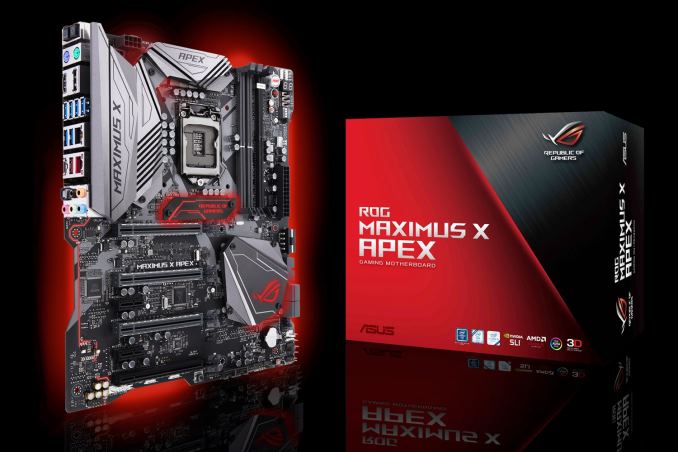
The ASUS ROG Apex line of boards have always been known for its focus on overclocking as well as unique design implementations like the "X" shaped board and the unique 'DIMM.2' slot - a DRAM-like slot for a bundled add-in card that can be used for two additional M.2 modules on a PCIe 3.0 x8 link. The Z370 ROG Maximus X Apex sticks with its pedigree and even adds a 5G network port to a long feature list.
AnandTech Intel Z370 Motherboard and CPU Coverage
- The Anandtech Coffee Lake Review: Initial Numbers on the Core i7-8700K and Core i5-8400
- Analyzing Z370 for Intel's 8th Generation Coffee Lake: A Quick Look at 50+ Motherboards
- ($397) The ASUS ROG Maximus X Apex Review [this review]
- ($250) The NZXT N7 Z370 Review [LINK]
- ($191) The SuperO C7Z370-CG-IW Review [LINK]
- ($180) The ASUS Z370-I Gaming [planned]
- ($150) The GIGABYTE Z370 Ultra Gaming Review [planned]
- ($144) The GIGABYTE Z370 Gaming WiFi Review [planned]
ASUS ROG Maximus X Apex Overview
Straight off the bat, it is hard to ignore that the Apex is not a rectangular motherboard. ASUS has cut the Apex into a more esoteric shape, almost like an X, to differentiate itself from other products on the market. It is a little odd, given generations of rectangles, although it is worth noting that motherboards do not have to be rectangles at all - as long as it fits in the standard, go crazy. The Apex fits the standard, requiring an E-ATX chassis, and the extra PCB area is used extensively for features.
The Maximus X Apex, by both pricing and feature set, places it in the high-end enthusiast segment for the Z370 platform. The Apex includes a lot of features focused on overclocking but is well rounded enough to do anything from gaming to workstation level activities. An example of the overclocking pedigree is in the upper right-hand corner, where there are several buttons, switches, and voltage read points that are all dedicated overclocking features to make extreme competitive overclocking easier.
To that end, the board uses two DRAM slots rather than the four we would normally expect to see on full-size, premium cost motherboards. ASUS mentions this was done to have better trace routing and helps with higher memory speed support, but also gives room for features such as DIMM.2, as shown below. The Apex also includes an Aquantia AQC108 5G LAN port for faster network connectivity and also has a bright RGB LED implementation. The ROG Maximus X Apex is a board aimed at users who want all of the performance out of this platform while not falling short most anywhere else.
The performance results for the Maximus X Apex placed it at the top of most of our benchmarks so far, leading nearly across the board from our small set of 300-series boards. The only point to pick up on might be the idle power consumption being higher, but that should be expected with a board like this with the extra functionality.
When manually overclocking our i7-8700K, it was met with no resistance from the board itself. We were easily able to push this CPU to 5.1 GHz passing our tests. 5.2 GHz brought us to a major voltage wall requiring an additional 0.1 volts, pushing our CPU temperatures well past the 90C limit we use. The automated overclocking (5-Way Optimization) through AI Suite 3 yielded a slight increase in performance, about 100 MHz for all threads (including AVX offset) and 300 MHz for single threaded clock speeds. The large aluminum heatsink covering the power delivery was able to keep them well within specification regardless of manual or auto overclocking.
The ROG Maximus X Apex removes M.2 connections on the motherboard and relies solely on the DIMM.2 add-in-card to attach any M.2 devices (SATA, PCIe, Optane). The add-in-card comes with a bracket in order to attach fans (sold separately) used to cool the devices below it. For SATA connected storage, the Apex gives users four ports, supporting RAID 0/1/5/10. The platform typically includes six SATA ports which are native to the chipset, but with four in use allows the board not to share PCIe resources with the SATA ports.
Somewhat unusual for the mainstream Z370 platform, the Apex comes with a total of four full-length PCIe slots (and two PCIe x1 slots). Three of the four full-length slots (grey reinforced) are connected to the CPU and will run at x16, x8/x8, or x8/x4/x4. The full-length slot at the bottom runs at x4 speeds from the chipset, and the x1 slots run at x1. This configuration allows the Apex to support both SLI (two card) and up to 4-way Crossfire.
The Apex has two USB 3.1 ports, Type-A and Type-C, located on the back panel IO and fed by the ASMedia ASM3142 controller. Sourced from the chipset are eight USB 3.0 ports with six on the back panel and the rest found as headers on the motherboard. It also includes six USB 2.0 ports via internal headers only.
The wired networking side of things is where ASUS really separates this board from most other Z370 options, including an Aquantia 5G network port alongside an Intel I219-V gigabit Ethernet port. I believe ASRock is the only other board partner to have anything above the gigabit mark. There is no wireless option here - the 5 GbE may be welcome to some, though I would imagine if there were a choice of options between wireless and 5 GbE, most users would select the wireless component as the infrastructure for multi-gigabit ethernet in the home still lags behind what enthusiasts have been demanding.
Competition
The Apex is not the highest end overclocking motherboard that ASUS offers on Z370, so one might assume that it does not compete directly with other halo motherboards. Ultimately it squares against anything that the competition has geared towards overclocking. Normally this would be products like the GIGABYTE SOC Force, the ASRock OC Formula, and the MSI XPower, however there is no Z370 SOC Force, there is no Z370 OC Formula, and there is no Z370 XPower. The other main manufacturers have focused moreso on gaming related models for Z370, tying in various OC features as required by the pricing segment. This is an odd situation to be in.
As we discovered recently, Intel is planning a Z390 chipset launch later this year, where the other manufacturers could be leaning towards that time frame for those versions of their motherboards. ASUS might also be doing this, as it has only launched the Hero/Code/Apex/Formula so far on Z370, and we have not yet seen the ROG Impact or ROG Extreme at this time.
The only motherboards near the Apex in Price currently are the ASUS Maximus X Formula ($450 MSRP, on sale for $350), ASRock's Z370 Professional Gaming i7 (MSRP $300, currently $285), ASUS's own Maximus X Code ($280), GIGABYTE's Z370 Gaming 7-OP ($270), EVGA's Z370 Classified K (MSRP $280, currently $236), and MSI's Z370 Godlike Gaming (limited edition).
ASUS Z370 Strategy
ASUS brings a number of Z370 motherboards to the table ranging from the Mini-ITX Z370-I Gaming to the flagship Maximus X Formula. The Republic of Gamers boards consisting of the Maximus and Strix series are most of the lineup, with the TUF and Prime lineups each having two boards. Prices range from $130 (Newegg) TUF-Plus for entry-level up to the flagship ROG Maximus X Formula at $441 (Amazon). It's a pretty wide price range with boards of all shapes, sizes, sizes and included features.
| ASUS' Z370 Motherboard Lineup (5/11) | |||
| AnandTech Review |
Amazon | Newegg | |
| ROG Maximus X Formula | $350 | $350 | |
| ROG Maximus X Apex | [this review] | $318^ | $318 |
| ROG Maximus X Code | $279 | $280 | |
| ROG Maximus X Hero Wi-Fi AC | $260 | $260 | |
| ROG Maximus X Hero | - | $241 | |
| ROG Strix Z370-F Gaming | $202^ | $180 | |
| ROG Strix Z370-E Gaming | $187 | $200 | |
| ROG Strix Z370-G Gaming | $196 | $208 | |
| ROG Strix Z370-H Gaming | $156 | $156 | |
| ROG Strix Z370-I Gaming | [in testing..] | $201 | $254 |
| TUF Z370-Pro Gaming | $152 | $151 | |
| TUF Z370-Plus Gaming | $156 | $125 | |
| Prime Z370-A | $160 | $164 | |
| Prime Z370-P | $130 | $130 | |
^ - 3rd party seller


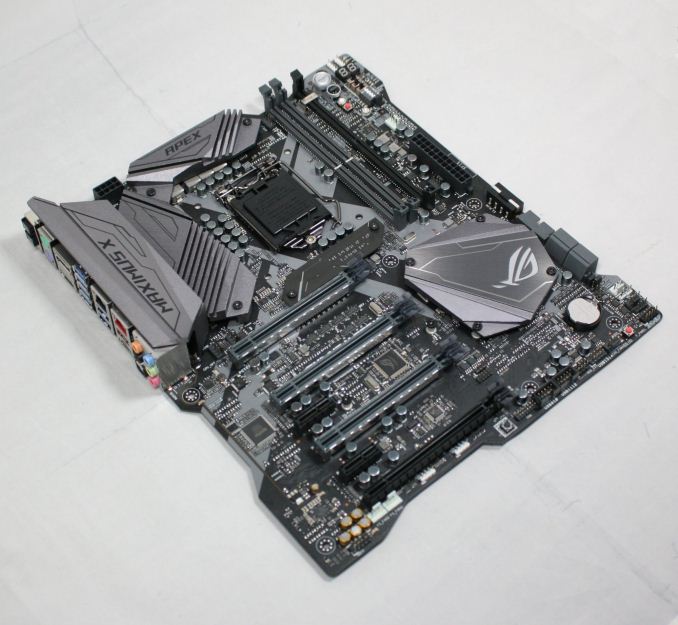
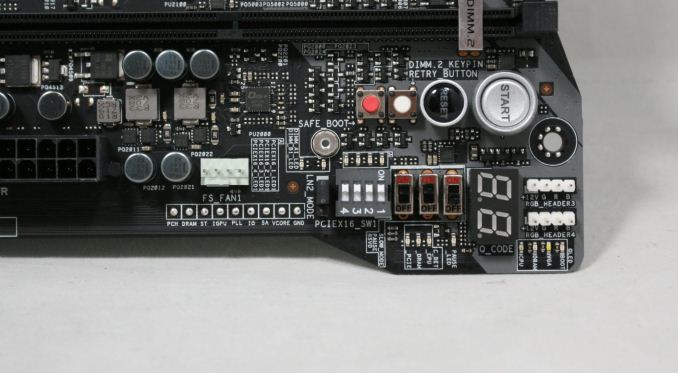
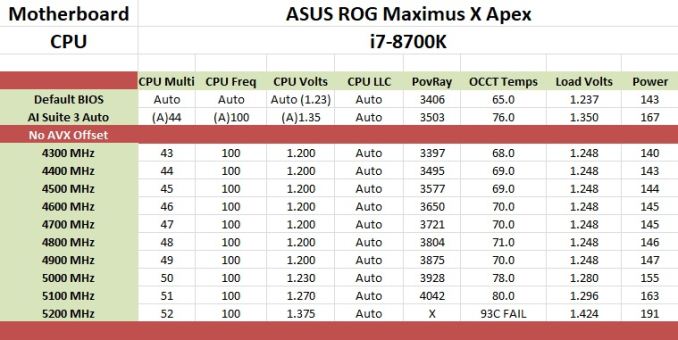
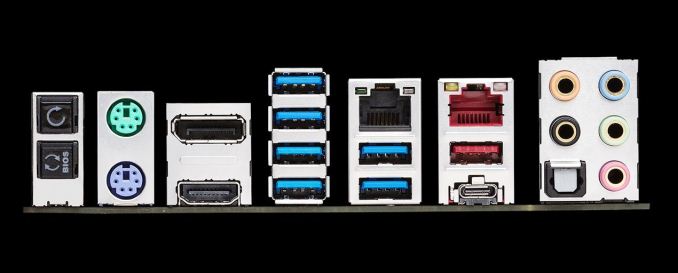
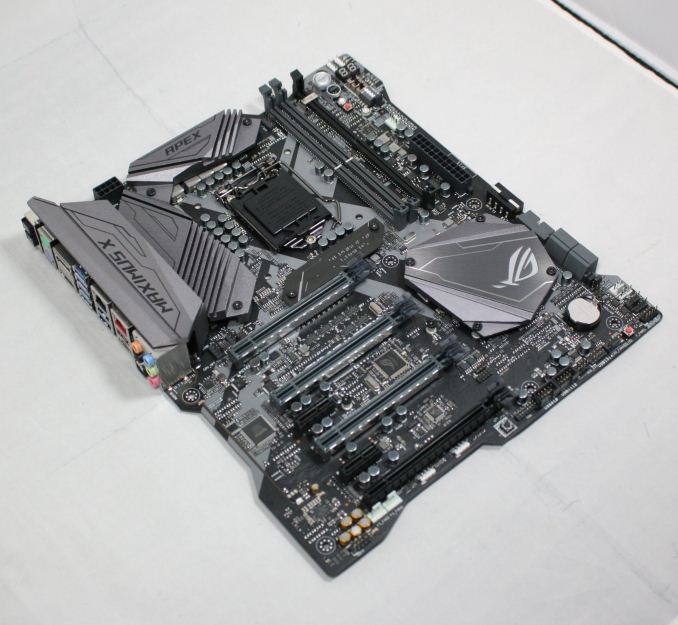








39 Comments
View All Comments
evernessince - Friday, May 18, 2018 - link
Correct although technically PS/2 could have lower latency in some situations. PS/2 keyboards and mice work based on interrupts while USB works by polling. In otherwards, when you press a key/click your mouse on a PS/2 device your request is immediately processed. USB on the otherhand waits until the device is next polled.TBH I've never seen a PS/2 vs USB latency test and I've personally never noticed a difference. Then again I haven't tested them strictly against each other on a high refresh rate monitor either.
voicequal - Friday, May 11, 2018 - link
Those active PS/2 to USB adapters never worked very well. Lots of missed inputs or stuck keys. The passive adapters require that the peripheral device switch into a PS/2 mode, supported by some mice, but not all PS/2 in general. Also some KVMs work only with PS/2 if that is your thing.HStewart - Friday, May 11, 2018 - link
10 USB Ports in way more than I can remember on motherboards. My Supermicro Xeon didn't have that many ports on it.But one thing I see missing in motherboards today is Thunderbolt 3 - maybe it is notebook thing - and future generation will have it. What is really nice is you can hook up dual Display Ports on it - not sure how that works with graphics cards today.
DanNeely - Saturday, May 12, 2018 - link
I think I've seen 1 or 2 boards with 12 out the back. 8/10 is around the normal upper limit though, partly for space reasons and partly due to chipset limits. For the last decade or so Intel's offered 14 USB ports on its high end southbridges with a gradually increasing number of the total supporting USB3; since most mobos have 2 or 3 on board headers for front panel ports or various misc internal uses (eg a few PSUs that connect to an internal 2.0 header to report stats) that leaves 8 or 10 total ports free for the back panel. Mobo vendors can get around this a bit by using onboard hubs or controllers (until recently this was the only way to get 10Gb ports), but to a large extent that's faking it until they can't make it. With a hub because you end up needing to know exactly what's going on inside the board if you need to connect multiple high speed devices at once to keep them from bottlenecking each other. PCIe controllers either end up with the same bottleneck problem, or if they have enough lanes to avoid it end up eating the equivalent number of SB ports instead.I've seen a few rumors that Intel's planning to integrate TB3 directly into the platform without needing a separate controller in the future. OTOH unless they add extra PCIe lanes to the CPU it's still probably going to be rare on desktop boards. TB3 is PCIe3 x4 equivalent, so a single connection on the southbridge could eat all of its bandwidth to the CPU. On most laptops to avoid that (and presumably to simplify the GPU out signalling) they use lanes from the CPU instead. On enthusiast desktops those 16 lanes are normally all used for the GPU though, and since PLXes PCIe switches are stupidly expensive now ($80 for a x16 to two x16 model) the only way to do that would be to limit the GPU to x8 instead of x16. In the real world that wouldn't matter much; but marketing is aimed at the clueless and a lot of them would freak.
Destoya - Wednesday, May 16, 2018 - link
The Asus Crosshair VI Hero has the most USB ports of any boards I'm aware of. 2x USB 3.1, 8x USB 3.0, and 4x USB 2.0 on the back panel for a total of 14, though to be fair it only has a single LAN port and no display out. Somewhat ironically for the new Crosshair VII, they dropped two of the USB 2.0 ports for a PS/2 combo port.DanNeely - Wednesday, May 16, 2018 - link
AMD's got a slightly higher max USB port count than Intel, 2 3.1g2 ports, 10 3.1g1 (4CPU, 6 chipset), and 6 2.0 ports; but even there that board is using at least one 3rd party controller for the front panel 3.1g2 header (or they could be routing the chipset ports to that header and using the 3rd party controller on the back).swapping 2 of the 2.0 ports for a PS/2 seems reasonable to me; some people want them (ie those whose high end keyboard is more than a few years old and doesn't support N-key rollover via an extension to the original ~20 year old spec/driver); and the list of devices that have interference problems one 3.0 ports is very short so not many people need more than 1 or 2).
OTOH other than cost reasons or wanting to keep space for their logo I don't see any reason they couldn't've added both; there seems to be enough back panel space for another stack of ports.
StevoLincolnite - Friday, May 11, 2018 - link
You could add another 5+ USB ports on the back I reckon.I can't be the only one with half a dozen external HDD's?
sibuna - Saturday, June 2, 2018 - link
if you are seriously using 1/2 a dozen external USB HDDs just build a NAS, it will serve you betterdgingeri - Saturday, May 12, 2018 - link
1. the PS2 ports run off a PS2 to USB adapter on the board anyway, so they really aren't proper PS2 ports. The X390 chipset doesn't support any path for PS2 ports. So, there really is no advantage on that.2. Those PS2 ports could easily be replaced with 4 USB ports, and they could be run with 2X 2.0 and 2X 3.0. There are enough USB 3.0 ports available from the chipset to do that. USB keyboards run better directly off the root hub anyway. The problems most people have with them having lost input usually comes because the keyboard is being run off a hub. On top of that, I know from direct experience, most USB hubs have major reliability and operational problems. I do my best to avoid running anything through a hub these days because of the repeated and consistent problems I have had with them. I seem to find a good hub once in a while, only to have it die a couple months later. We NEED those ports on the back of those boards, and then some dumb engineer comes up with the idea to use 2 of those ports to make one USB-C header for some front panel port that is supported by only 1 case. My Maximus X Hero Wifi has only 8 ports, so I'm stuck with running my UPS, Nostromo, and mouse off a hub, which is not what I like.
3. There are a LOT of people who go for such advantages in hardware who are just fantasizing over it making them a better player, when it simply won't help. So, stop with the idea that any more than a very bare few actually need PS2 ports.
DanNeely - Sunday, May 13, 2018 - link
This is a Z370 board, and Z370 still has an LPC bus (a quasi-serial version of the ancient ISA bus) which has been the traditional location to mount the control chip for PS2 and other ultra-legacy IO ports. Without scouring the board images itself to figure out what controller is being used, I can't answer how it's being connected but the chipset does have the IO needed to support a non-USB PS2 port.And while the chipset does have theoretical additional USB3 lanes available, it doesn't have free HSIO ports to run them on without going into configuration hell where using feature X disables feature Y, Z370 has a total of 30 of them to split among USB3, SATA, and PCIe lanes from the chipset. The board breaks down as:
1 Intel network
1-4 AQC108 5GBe (maybe only 1-2, the Aquitania page doesn't differentiate between requirements for their 5 and 10Gb controllers)
1 Realtek audio
4+1+1=6 PCIe lanes
4 Sata
4+4=8 M.2 slots
6+2 USB3.0 (back panel and front panel header)
2 ASM USB3.1g2 controller
That adds up to 31-34 already so at least one item is already being switched on/off depending on what else is in use.
https://content.hwigroup.net/images/editorial/1920...